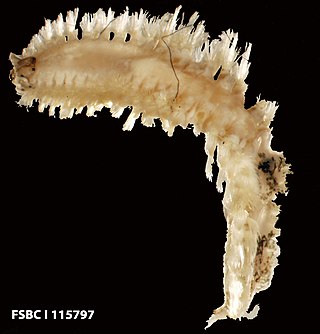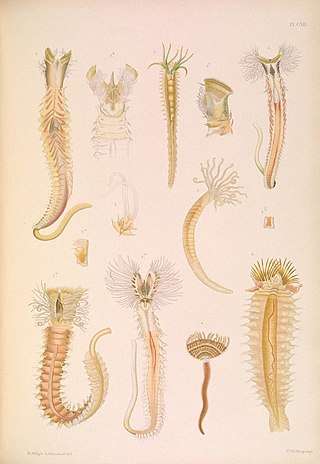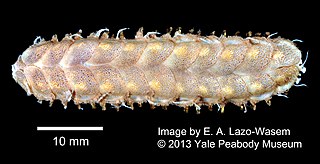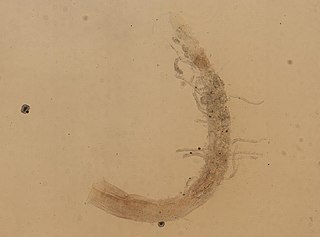
The genus Glycera is a group of polychaetes commonly known as bloodworms. They are typically found on the bottom of shallow marine waters, and some species can grow up to 35 cm (14 in) in length.

Nereis is a genus of polychaete worms in the family Nereididae. It comprises many species, most of which are marine. Nereis possess setae and parapodia for locomotion and gas exchange. They may have two types of setae, which are found on the parapodia. Acicular setae provide support. Locomotor setae are for crawling, and are the bristles that are visible on the exterior of the Polychaeta. They are cylindrical in shape, found not only in sandy areas, and they are adapted to burrow. They often cling to seagrass (posidonia) or other grass on rocks and sometimes gather in large groups.

Harmothoe is a genus of marine Polychaete worms belonging to the family Polynoidae. Species of Harmothoe are found world-wide to depths of at least 5,000 m but are more common in shallower water.

Ampharetinae are a subfamily of terebellid "bristle worm". They are the largest subfamily of the Ampharetidae, of which they contain the great majority of the described genera.

Phyllodoce is a genus of polychaete worms, which contains about 200 species. The prostomium bears eyes, two pairs of antennae and a pair of large retractile nuchal organs. The eversible proboscis is clearly divided into two parts.

Cirratulidae is a family of marine polychaete worms. Members of the family are found worldwide, mostly living in mud or rock crevices. Most are deposit feeders, but some graze on algae or are suspension feeders.

Amphinomidae, also known as the bristle worms or sea mice, are a family of marine polychaetes, many species of which bear chaetae mineralized with carbonate. The best-known amphinomids are the fireworms, which can cause great pain if their toxin-coated chaetae are touched or trodden on. Their relationship to other polychaete groups is somewhat poorly resolved.

Terebellides is a genus of polychaete worms in the family Trichobranchidae.

Eulalia is a genus of polychaete worms.

Syllidae, commonly known as the necklace worms, is a family of small to medium-sized polychaete worms. Syllids are distinguished from other polychaetes by the presence of a muscular region of the anterior digestive tract known as the proventricle.

Lepidasthenia is a genus of marine Polychaete worms belonging to the family Polynoidae. Species of Lepidasthenia are found worldwide to depths of about 1200 m but are more common in shallower water.

Eunoe is a genus of marine annelids in the family Polynoidae. The genus includes 48 species which are found world-wide, mostly from depths of 50 m or more.

Lepidonotus is a genus of marine annelids in the family Polynoidae. The genus occurs globally and includes 80 species, usually found in shallow waters down to about 80 metres.

Eunoe oerstedi is a scale worm which is widely distributed in the Arctic Ocean, North Atlantic Ocean and North Pacific Ocean from shallow waters to depths of about 950m.
Eucranta is a genus of marine annelids in the family Polynoidae. The genus includes 5 species which are globally distributed from depths of about 40 to 600 m, mostly from high latitudes in the northern and southern hemispheres.
Gattyana is a genus of marine annelids in the family Polynoidae. The genus includes 11 species, 9 of which occur in the northern hemisphere, the remaining two are from the Indian Ocean off Mozambique and the Southern Ocean off New Zealand. Species of Gattyana are known from shallow water down to depths of about 1200 m.
Hermadionella is a genus of marine polychaete worms belonging to the family Polynoidae, the scaleworms. Hermadionella contains 3 species which are known from the north-west Pacific and Arctic Oceans from the intertidal to depths of about 200 m.

Ophelina is a genus of annelids belonging to the family Opheliidae.
Prionospio is a genus of annelids belonging to the family Spionidae.















